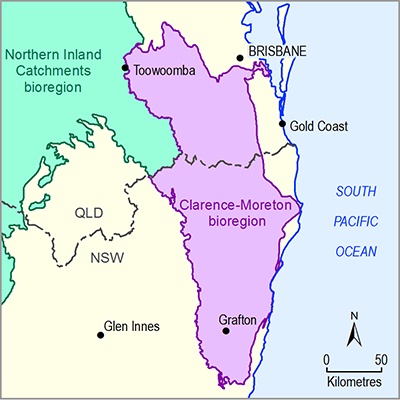- Home
- Assessments
- Bioregional Assessment Program
- Clarence-Moreton bioregion
- 5 Outcome synthesis for the Clarence-Moreton bioregion
- What are the potential impacts of the hydrological changes?
The assessment found that the maximum potential hydrological changes due to additional coal resource development in the bioregion occur during low flows in the Richmond River at Casino and Shannon Brook at Yorklea, south of Casino.
The model predicted only very small hydrological changes and therefore the potential impacts were not further assessed.
The landscape classes and water-dependent assets were summarised for the bioregion. This information is highlighted below and is available for future assessments or monitoring programs.
Landscape classes
Hydrological changes can impact ecosystems, such as wetlands, irrigated agriculture or dryland remnant vegetation, at a landscape scale.
Ecosystems in the Clarence-Moreton bioregion were classified into 35 landscape classes. Landscape classes were aggregated into landscape groups based on whether they respond similarly to changes in groundwater and/or surface water.
More than half of the bioregion is used for dryland agriculture (57.5% of the assessment extent, which is the area in which potential impacts to groundwater and surface water systems are investigated). Natural vegetation covers 37.8% of the area, including woodlands, open forest and rainforest.
The landscape classification is based on the geology; the physical features of the region, known as geomorphology; hydrogeology, which describes the way water moves underground; land use; and ecology. Existing classification systems and datasets were used where relevant and modified as necessary.
Water-dependent assets
At the start of the assessment, representatives from governments, natural resource management groups and community groups identified more than 2000 ecological, economic and sociocultural assets of value to the community. The list of these assets that could potentially be affected by changes in water due to coal resource development, known as water-dependent assets, included (as of August 2015):
- 1520 ecological assets, including the potential habitat of 186 threatened or endangered species, 4 globally important habitats for birds, 170 wetlands, 7 threatened ecosystems, and 157 ecosystems that rely on groundwater
- 752 economic assets, including water access rights
- 160 sociocultural assets, including 110 recreational sites, 15 heritage sites and 35 Indigenous sites.
FIND MORE INFORMATION
Description of the water-dependent asset register, product 1.3 (Murray et al., 2015a)
Water-dependent asset register, list for product 1.3 (Murray et al., 2015b)
Conceptual modelling, product 2.3 (Raiber et al., 2016b)
Landscape classification (Dataset 12)
Data on water-dependent assets (Dataset 11)

Product Finalisation date
- Explore this assessment
- About the bioregion
- How does the bioregion's geology and hydrogeology influence water movement?
- How could coal resource development result in hydrological changes?
- What are the potential hydrological changes?
- What are the potential impacts of the hydrological changes?
- How to use this assessment
- Building on this assessment
- References and further reading
- Datasets
- Contributors to the Technical Programme
- Acknowledgements
- Citation
